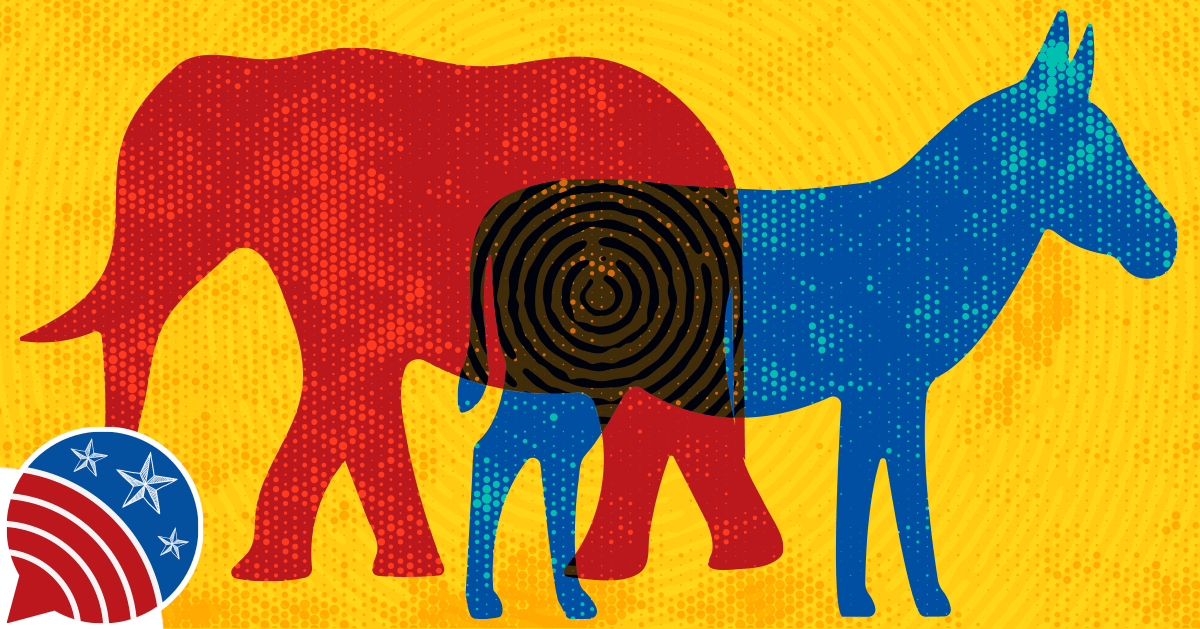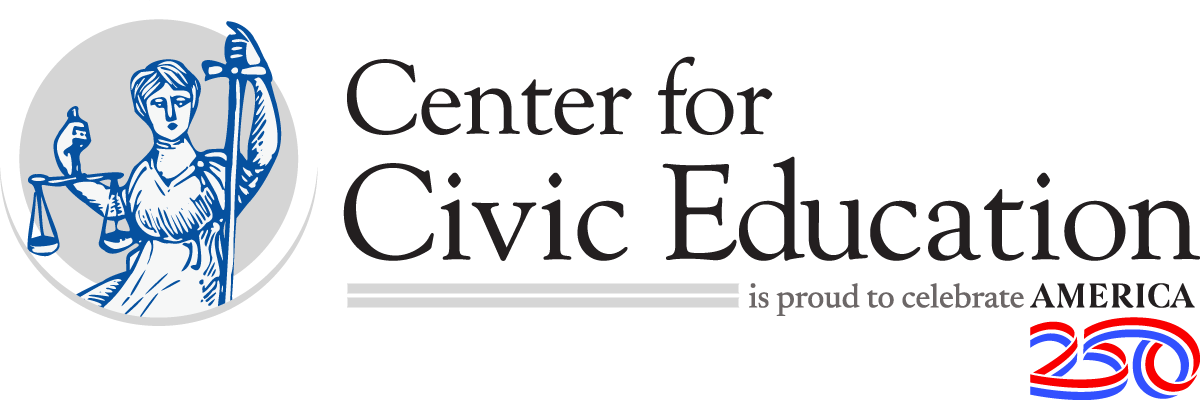
The Evolution of Political Parties
Session Plan
- Begin by asking participants if they are familiar with the concept of factions or interest groups.
- Explain that in a democratic society, different groups with similar interests are called factions, and they can have both positive and negative impacts.
- Ask participants to name any factions they can think of (historical or contemporary) and list on board or chart paper.
- Have a brief discussion to explore their understanding and examples of factions in contemporary society.
- Discuss examples of groups they belong to, such as clubs, sports teams, or social media communities.
- Introduce Federalist 10 as an essay written by James Madison to address the issue of factions in the early United States.
- Chart Paper (1 sheet/group)
- Markers
- Sticky Notes
Tell participants that today we will be focusing on some of the big issues and ideas being grappled with during the early days of the United States of America.
Option 1: Whole Class Exploration
- Share the 1st podcast, “Functions of Political Parties” with your students.
- While they view/listen to the recording, ask students to pay attention to references being made to some of Madison’s thoughts about the impact of factions on the new nation.
- After watching/listening to the podcast, ask one student to share out a brief summary of the ideas and topics discussed. Prompt other additional students to correct or expand upon the shared summary.
- Repeat this process for the remaining four podcasts adding questions and wonderings to fuel reflection and inquiry, based on each of the 60-second podcasts.
Option 2: Small Group Activity
- Divide the class into small groups (4-5 students each). Prior to the activity, set up "stations" with each station setup with 1 of the 4 remaining podcasts. Assign each group to a specific station.
- Podcast episodes can be cued up with a link or QR code on the paper. Students can use phones or devices, or tablets can be set at each station.
- Tell each group that they will have 5 minutes at each station until they are prompted to rotate.
- When they arrive, they will have one minute to actively listen to the podcast (taking notes on key points, interesting facts, or any thoughts that arise). At the end of the podcast, students will have 4 minutes to write down their reaction questions and thoughts on that station’s chart paper.
- After 5 minutes, students will be prompted to rotate counterclockwise to the next station.
- Repeat steps 3 and 4 until each of the stations has been by each of the groups.
- Each group will have 5 minutes to review the reflection notes found on the chart paper at their final station.
- Prompt groups to identify any trends or common reactions on their chart paper.
- At the end of the 5 minutes, ask each group to share their findings.
- Open a whole-class discussion to elevate questions, wonderings, and key ideas.
Extension Opportunity: George Washington's Farewell Address
- Provide participants with text of George Washington’s Farewell Address (1798) referenced in the 5th podcast. Explore more deeply his fears of political parties.
- Which of these fears are still relevant today?
Extension Opportunity: Beyond the Legacy Video Guide
- After discussion of the 60-second podcasts, share the Beyond the Legacy Video: Political Parties and Conservatism. (LINK) Use any or all of the questions noted below and additional questions in the resource Beyond the Legacy Video Guide: Political Parties.
- What is the essential view about central government power that relates to conservatism?
- How did the Republicans and Democrats in the 1960s view Civil rights in relation to conservatism?
- What does Dr. Brooks say the parties have done for each other with regard to liberal and conservative threads throughout history?
- What are the purposes of political parties?
- How does the popular vote in 1824 shape the function and role of political parties?
- According to Dr. Brooks, what is one of the biggest challenges to political parties today?
- From your own views and experiences, what do you think about this challenge?
- How is liberalism in the founding era exemplified by the question of how much you believe in the people?
- Why is it hard to trace a direct line from our earliest parties to today’s political parties?
- How did the popular vote change elections and electioneering?
- How was liberalism expressed during the Civil War/ Reconstruction era? What were some of the differences between each party?
- How is liberalism expressed during Roosevelt’s presidency?
- How did the election of 1800 highlight the differences and squabbles within each political party?
Extension Opportunity: Federalist 10
- Now that participants have been exposed to references to Federalist 10, transition to a review of that text to deepen their understanding of the nature of political parties, factions, and their role in our history and today.
- 60-Second Civics Podcast: The Evolution of Political Parties in America
- Federalist 10
- George Washington’s Farewell Address
- Beyond the Legacy Video: The Evolution of Political Parties in America
- Beyond the Legacy Video Guide: Political Parties
- Chart Paper
- Markers
- Sticky Notes
- Interactive Whiteboard
- Digital Collaboration Space
Discourse Launch Activity
Note: The following steps are the beginning of the Paideia seminar process, which entails taking a deep dive into the text. Whether doing the Paideia or the Structured Academic Controversy (SAC) as the discourse model (or both) these steps provide the opportunity to access the text for use in either discourse activity.
- Begin by asking participants if they are familiar with the concept of factions or interest groups. Explain that in a democratic society, different groups with similar interests are called factions, and they can have both positive and negative impacts.
- Have a brief class discussion to explore their understanding and examples of factions in contemporary society. Discuss examples of groups they belong to, such as clubs, sports teams, or social media communities.
- Introduce Federalist 10 as an essay written by James Madison to address the issue of factions in the early United States.
- Text Support Option: Teachers can use the Close Reading Template to add the text which provides a strong framework for analyzing and understanding complex text. In using this template, teachers will need to develop text-dependent questions to support students’ comprehension. This is a powerful tool to support literacy in all learners in addition to scaffolding in preparation for the civil discourse.
Primary Text Inspectional Read
- Distribute the texts, Federalist 10. Discuss with participants what they anticipate the text is about.
- Have them number the paragraphs in the text (1-24). Then ask participants to read the text while highlighting unfamiliar words and phrases.
Vocabulary
- Have participants share the words and phrases they found unfamiliar while a volunteer lists them on the (interactive) whiteboard. Be sure to include:
- Use your preferred practices for front-loading vocabulary comprehension in a complex text.
- Alternatively, assign the words and phrases to groups of participants to research and define.
- Have the groups share with the entire class and discuss until all participants are comfortable with the surface meaning of the text.
Analytical Read
- Have participants read through the text selection again, slowly highlighting the three most impactful lines or sentences.
- Then in the margins of the selections, ask students to write notes on what makes those lines or sentences so compelling.
- Chart Paper (1 sheet/group)
- Timer (optional)
- Sticky Notes
- Markers
- Federalist 10
- Highlighters
Note: Choose one or both of the discourse models below.
Civil Discourse Model #1
- Paideia Seminar: A Paideia Seminar is a collaborative, thought-provoking dialogue about a text selection, facilitated with open-ended questions. The main purpose of the seminar is to arrive at a fuller understanding of the textual ideas and values, of ourselves, and of each other. The discussion will be on Federalist 10 and James Madison’s views on factions. Participants will make active connections between these ideas and the impact political parties have on our lives today.
Civil Discourse Model #2
- Structured Academic Controversy (SAC): In the structured academic controversy, participants are assigned a stance on a question and work to come to a consensus on a contentious issue. The strategy reinforces the idea that before people commit to a side, they should seek to understand the argument of the other side. The goal of a SAC is not to win; rather, SACs should give participants adequate time to present content knowledge and diverse perspectives as well as time for clarification questions, small group discussion, large group discussion, and consensus building. The predetermined format allows for structure and support for multiple viewpoints to be heard, understood, and validated while informing everyone’s views on the question of whether political parties have had a net positive effect on America.
- Paideia Seminar Plan - Federalist 10
- Option: Use the Paideia Plan template and engage with a different text such as George Washington’s Farewell Address or combine the use of two texts.
- Highlight some of the ideas discussed during the previous day’s discourse model(s). Be specific and explicitly connect comments and ideas to the participant that shared them.
- Return to the Inquiry Question:
- Are the ideas and warnings about factions shared in Federalist 10 still applicable today? OR
- Have political parties had a net positive effect on America?
- As a pre-writing exercise, participants should be encouraged to revisit notes they captured on the margins of their text selection, personal recording space, etc. and during the Launch Activity to refresh their memories of earlier discussions on this topic.
- Select one or both activities below to assess and authentically engage participants as you conclude this discourse.
Writing Task
- Are Madison’s thoughts and arguments from Federalist 10 still valid today? Pick a contemporary issue and evaluate whether or not factions have made the United States stronger or weaker as a result of their influence.
Extension Task
- Which idea(s) from the seminar and/or SAC still interest and intrigue you? Using notes from the dialogues, research the issue further. Share new resources with classmates. Suggest new questions to consider for future dialogues.






